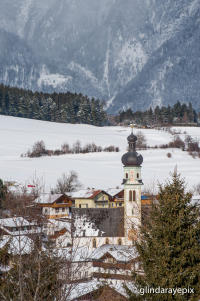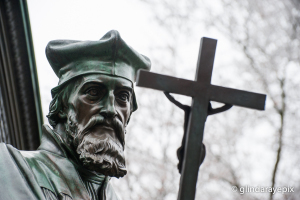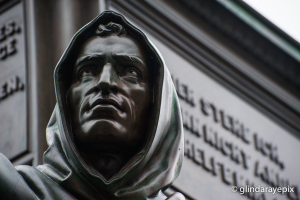James Lockhart Perry's Blog, page 5
October 25, 2017
Nancy

On 10 May, 1951, in a true exercise in dynastic futility, Archduke Franz Joseph Otto Robert Maria Anton Karl Max Heinrich Sixtus Xaver Felix Renatus Ludwig Gaetan Pius Ignatius von Habsburg-Lotharingen married Regina Helene Elisabeth Margarete, Princess of Saxe-Meiningen. The ceremony took place here in Nancy, France, at l’église de Saint-François-des-Cordeliers.
The union was preceded by all of the byzantine debates, negotiations, and sanctions that attended any dynastic marriage of the Habsburg family. The succession to the imperial throne of Austria, Hungary, and Bohemia was secured—except for the minor quibble that said empire no longer existed.
In 1918, the Habsburgs were unique among the failed monarchs of Europe for not actually abdicating their throne. For the rest of the century—until 2007, in fact—they persisted in believing that a return to power lay around some steadily receding corner. Nazis, Communists, and democrats came and went, but none of those pretenders had divined the true monarchic soul of the faithful. Othon I, as he styled himself, continued to hand out titles and confer make-believe favors like any reigning monarch beloved by his non-existent people.
It was said of the Habsburgs that they built their empire the hard way—through marriage. So it was fitting for this archaic union to take place next door to the one-time Palais des Ducs de Lorraine. On 14 February, 1736, one of those Dukes, Francis I, exchanged his duchy for marriage to Maria Theresa of Austria and the imperial crown of the Holy Roman Empire. In spite of his serial adultery, the couple managed sixteen off-spring. Nine of the children died prematurely, the most famous being Marie Antoinette of France, who dutifully married the bumbler Louis XVI and then lost her head in the French Revolution.
So from the cold castles of Lorraine to the trendy beaches of Marbella and the sweaty discos of Saint-Tropez, marriage has always been one serious business for this Habsburg family. It just no longer matters to the rest of us.

Filed under: Europe Tagged: France

October 5, 2017
Roma

A detail from the Roman victory column, Columna Centenaria Divorum Marci et Faustinae, shows how bloody and gruesome most Roman victories were. This particular structure, from AD 193, honors the old sage and Emperor Marco Aurelio (bearded and dispensing wisdom at top left) for his assiduous repression of the Germanic tribes being mauled in the battle below.
As related in the movie The Gladiator, Marco (played by Richard Harris) did indeed die while off fighting the Germans. Although no one blamed his disappointing son Commodus, the latter’s descent into paranoia and more than a touch of madness proved the first serious tipping point on the long slide into oblivion of the Roman Empire.
Commodus loved playing the gladiator and practiced for each of his wildly popular public bouts by murdering a handful of half-armed slaves. But unlike the Joaquin Phoenix character, he did not die in combat with a handsome Australian. After executing his sister Lucilla (Connie Nielsen in the movie) for attempting his assassination, he was finally brought down by his mistress Marcia. She started with poison in his lunch and, when that failed to do the trick, seduced the wrestler Narcissus into strangling the weakened Emperor in his bath.
Slaves, sparring partners, and rival statesmen breathed sighs of relief.

Filed under: Europe Tagged: Italy

January 12, 2017
Tirol

No one was ever given a nastier clutch of nicknames than Margaret, the last Countess of Tyrol: Maultasch, Mouth Bag, Whore, Vicious Woman, Medusa, Mouth-Poke, Pocket-Mouth, Satchel-Mouth, Big Mouth, Pouch Mouth, the She-Wolf of the Tyrol, the Ugly Duchess, and Kriemhild (after the wife of Attila the Hun).
Margaret, naturally enough, was a remarkable beauty (with exquisite lips!) who just happened to run afoul of the church authorities. Her sin was that she booted her feckless, philandering husband, John Henry, out of their schloss in the Tirolean Alps when he returned late one night in November, 1341, from a particularly nasty bender.
 None of the neighbors was surprised. Ever since meeting each other at their wedding vows—at ages eight and nine—the couple had famously despised each other. According to Margaret, they never even consummated their marriage. So when she finally lost her patience, all the other castles refused John Henry entry. Friendless, he scarpered off to far Bohemia and a lifetime of pampered uselessness.
None of the neighbors was surprised. Ever since meeting each other at their wedding vows—at ages eight and nine—the couple had famously despised each other. According to Margaret, they never even consummated their marriage. So when she finally lost her patience, all the other castles refused John Henry entry. Friendless, he scarpered off to far Bohemia and a lifetime of pampered uselessness.Margaret disavowed her husband and immediately remarried without benefit of an annulment. This was too much for the church, which excommunicated her and started one of its characteristic smear campaigns. Margaret responded the only way a woman in her era could. She fought off the Luxembourgs and Wittlesbachs and threw in with the Hapsburgs. Rudolf IV of Austria got the excommunication lifted and allowed Margaret to retire to Vienna. But she never again set eyes on her gorgeous, snow-swept Alps.

Filed under: Europe Tagged: Austria

January 11, 2017
Der Rhein

Everything has to start somewhere. This bridge in Konstanz on the Swiss border marks the official start of the Rhein River, or point zero on the 1939 Rheinkilometer scale. From here, the Rhein flows west and north through Germany, Switzerland, France, and the Netherlands to de Hoek van Holland and marker 1036.20.
We’ve always wanted to drop a motor-free boat in here and simply float downstream to the Hook. You can do it too, thanks to centuries of engineering and several canals. For most of the river’s history, you would have been arrested several times over as a spy, of course, but these days, things are much more friendly.
This course ignores the two upper Alpine Rhines that feed Lake Constance from Lake Toma in southern Switzerland. The cycling route EuroVelo 15 starts near there in my old stomping grounds of Andermatt and runs 1,233 kilometers through 9 UNESCO World Heritage Sites before it ends at the Hook. Pack really high quality rain gear. It will get a lot of use.
The Romans considered the Rhein the absolute outer edge of civilization and only crossed it in an occasional publicity stunt for home consumption. For centuries, the French tried to make it the official border with Germany, even though the Germans had long populated what they called the Rheinland on the western bank. In 1918, the victorious French occupied the area, but then withdrew. In 1936, when Adolf Hitler kept his election campaign promise to move back into the Rheinland, the French could have easily brought his government crashing down and maybe even prevented World War II (he certainly thought so). But by then, they were too quarrelsome and exhausted to even try.
From childhood, I recall massive traffic jams along the Rhein, with massive convoys of American tanks and troops endlessly shuttling back and forth for all to take note. I also recall heaps of rubble and bullet-ridden buildings still left over 20 years after the War. And a lot of people still talking about the War, especially the Germans, always explaining something.
Today, that part of our shared history seems to have vanished. These days, the Rhein is all about connection rather than division. Sounds like a good enough thing.
Filed under: Europe Tagged: Featured, France, Germany, Netherlands, Switzerland

The Bosna
Sooner or later, you’re going to try one of these, as they spread all over the world. The Bosna was invented in 1950 by the Balkan Grill Walter, a pretentious name for a tiny closet with a window in an alley off the Salzburg Altstadt. If you can bear the long lines of local enthusiasts, even in subzero weather, you’ll be munching on the walk-around sandwich of your dreams.
Two skinny brats with onions, fresh parsley, a dusting of curry powder, and enough mild Austrian mustard to fill the toasted bun. Ketchup for the Americans, although we don’t recommend it. Sounds easy? Then why haven’t McDonalds or Starbucks stolen the formula?
Since its birth in Salzburg, the Bosna has spread from alp to valley, to every walk-up comfort food window in Austria. Conde Nast Traveller deems it a one-sandwich food group. We couldn’t agree more. Healthy? Not exactly. But in a driving blizzard, with or without a semi-frozen lager in your fist, the Bosna will make you forget those sunny Californian skies of last month.
We should know.
Filed under: Food Tagged: Austria, Featured

January 10, 2017
Worms

The 38-year-old giant Martin Luther kicked the Protestant Reformation into high gear on this spot when he stood before the 1521 Diet of Worms to defend his Ninety-Five Theses. Like Jan Hus before him in1415, he was guaranteed safe passage by the Catholic Church fathers, only this time they actually honored it. The Holy Roman Emperor Charles V and everyone who mattered heard Luther utter the famous line, “Hier stehe ich, ich kann nicht anders, Gott hilfe mir!” or “Here I stand, I can do no other, God help me!”
Pope Leo X excommunicated Luther, and the Emperor outlawed him, but by then reformers were everywhere. Luther himself tried to restrain the Reformation and limit it to theological changes, but his translation of the Bible into German and the explosive spread of the printing press made this impossible. Overnight, anyone could read, interpret, and act on the Word of God in a language he could actually understand. The Christian world quickly evolved from a tightly scripted unity into the quarrelsome patchwork of faiths and sects we know today.

More than 8 million people died as Europe descended into the massive religious conflict that culminated in the Thirty Years War. Germany and Central Europe degenerated into a wasteland as rising powers like the French, Dutch, and Swedes fought the Austrian and Spanish Hapsburgs for control. In 1648, the Peace of Westphalia finally accepted the religious schism and for the first time removed the Roman Catholic church as an earthly power. Pope Innocent X condemned the Peace as “null, void, invalid, unjust, damnable, reprobate, inane, empty of meaning and effect for all time.” An exhausted Europe, including his own people, ignored him.
Luther would survive to organize his church, rail against the Jews, write a boatload of hymns, and marry the nun Katrina von Bora after helping her escape from her convent in a herring barrel. The town of Worms would go on to suffer the fate of many a central German city—sacked and plundered in multiple French invasions and demolished by the British RAF in 1945. The Heylshof Garden, where Luther took on the entire Roman Catholic world, has been replaced by a collection of statues squeezed between the ring road and the best pizza joint in town. People rush by.

Filed under: Europe Tagged: Germany

Friedrichshafen

The 1937 Hindenburg disaster in Lakehurst, New Jersey, was only the most famous of the mishaps to befall the airships produced by the Graf Zeppelin Works here at Friedrichshafen on Lake Constance. Several never made it out of the hanger. LZ2 and LZ44 lost their engines and collided with alps. LZ60 broke loose in a gale, vanished out to sea, and was never seen again. Several blew away in storms or caught fire in landings and collisions with trees. In wartime use, these lumbering, massively explosive behemoths made irresistible targets for anyone with a machine gun.
But hucksterism was as important as engineering to many a 19th century industrial genius, and Graf Ferdinand von Zeppelin excelled at both. After a balloon flight while observing the American Civil War, he caught the bug and then worked on the Imperial German government and public until they caught it too. It didn’t matter that the American State of Kansas had produced every whiff in existence of the safer gas helium or that the Americans had embargoed its export. Graf von Zeppelin turned to hydrogen, one of the most explosive gases on the planet, with explosive results.
In the end, fewer than 130 airships were built—compared with 5,490 Sopwith Camels or 12,731 B-17 Flying Fortresses. The damage the ships did never measured up to the complications of housing, manning, and flying them in the ugly north European weather. But in World War I, the Zeppelins did introduce the English, Belgian, and French publics to the horrors of indiscriminate aerial bombing. A 1914 attack on Liège in Belgium missed its target, killed nine civilians, and set a gruesome pattern for the future.
During World War II, the German city of Konstanz sat close enough to the Swiss border that they never even turned off the lights, much less endured an air raid. Across the lake, Friedrichshafen was flattened. Reichsmarschall Hermann Göring had already grounded the Zeppelins, but the works here still produced Dornier bombers and parts for the infamous V2 rockets that rained down on London.
Today, those are all gone, but the Zeppelin has been resurrected with Goodyear as a key customer. We scheduled a 30-minute ride in the local (helium-filled) airship this week, but then it was grounded—by the weather, of course.
Filed under: Europe Tagged: Germany

January 8, 2017
Kitzbuhel

It’s an oddity of the East-West orientation of the Central European mountains that the ebbs and flows of ice ages of the last 2000 years have repeatedly wiped out and then replenished the Austrian and German forests. The legendary Walder we drive through today are the result of a romantic 19th century attempt to replant the Bavarian and Alpine plateaux. No Roman Legionnaire would recognize our organized landscape from his perch atop the limes Germanica that protected his delicate civilization from the Barbarians.
Some major forest uses are gone—beekeeping from before the advent of sugar, charcoal for glassmaking, yews and oak for weapons, firs for smelting and mining. It was said that an entire German oak forest sank at the Battle of Trafalgar in 1805, but these days most ships sunk in anger are made of steel. Hunting and skiing have become more recreational than essential. The great farm hearths fed by firewood gathering are more decorative than practical.
Apart from pollution, the biggest threat to the modern European forest is the proliferation of deer with their omnivorous eating habits. So hunting is encouraged, mainly during the fall rutting season when you can hear the bellows of red stags and the crack of Mouflon ram horns echoing across the alps. The only animal that is still hunted year-round is the wild boar. In the closest thing to old-fashioned society hunts, you will find lines of BMWs at the entrance to a forest trail, as their owners figure out which end of the rifle to point at their eyes.
Hunting blinds are found everywhere in the Alps, but in a wild January like this one, outside of hunting season, they mainly serve as great photo subjects for people like us.

Filed under: Europe Tagged: Austria

Konstanz

In 1415, the Roman Catholic faith had sunk into complete moral and political collapse. With no answers for more than a century of famine, plague, pestilence, and nonstop warfare, the church authorities instead exhausted themselves fighting over the meagre spoils of a civilization gone rotten.
Three different Popes claimed the Throne of St. Peter—Gregory XII, Benedict XIII, and John XXIII—with a viciousness that would make a modern politician blush. Sodomy, simony, extortion, all manner of thuggery were alleged, and only because they actually happened. Priests squeezed the increasingly impoverished peasantry for phony indulgences none could afford. Papal Bulls and Crusades were spat out with all the cynical abandon of a modern Imam’s Fatwas and Jihads.
So in 1415, when the church fathers arrived here on the German-Swiss Bodensee for the Council of Constance, they knew they had to do something. The European world held its breath while the Popes were dismissed—the Frenchman and the Italian resigning, the Spaniard putting it all on the Jews until he was excommunicated anyway. But this left the question of what to do with the growing chorus of cries for fundamental reform.

Here the fathers made a fatal error. They guaranteed the great Czech priest Jan Hus safe passage to come to Konstanz and explain himself, but then changed their minds and burned him at the stake. Naturally, they gave Hus a chance to recant—or, in modern terms, to sell out—but with an obstinacy that might sound foreign to our timid sensibilities, he turned them down.
It would take another 100 years for the ensuing outcry to grow into the Protestant Reformation, and several centuries of riot, civil warfare, and mayhem before the new churches emerged as we know them today. But everything has to start somewhere, and if you’re a Protestant Christian, your faith might as well have been born in the flames spiraling heavenward from this square.

Filed under: Europe Tagged: Germany

January 7, 2017
Vaduz

Liechtenstein, the world leader in false teeth, gaudy postage stamps, and a whole lot of black money. We’re assuming it’s pure coincidence that they speak so odd and unintelligible an Alemanic dialect of German here, but it hardly fits with one’s image of the second-richest country in the world.
Sometimes it seems like these tiny European countries—Monaco, San Marino, the Vatican, Andorra, and Liechtenstein—were developed purely with the modern tourist in mind. But in the chaotic history of the Holy Roman Empire and the Napoleonic age, survival was almost entirely a matter of picking the right side. No one exceled the Princes of Liechtenstein in this, as they rode the Hapsburgs to power and then played off the French.
In those days, you didn’t even need to live in the country you ruled. The Princes of Liechtenstein stayed in Vienna and relied on emissaries to collect their taxes. To this day, they maintain their world-class art collection in a museum there. But in modern democratic times, parliaments have a way of deposing absent-minded monarchs, so for the last 100-plus years, the Princes have at least made an appearance of living in the castle in the photograph. If they still send their long-term criminals to Austria, they have at least joined the Swiss for financial transactions.
You knew that Liechtenstein was on the way to the future when, in 1985, 51.4% of the male voters finally agreed to give women the vote. Otherwise, not much has changed. Last night, we caught a crowded outdoor religious ceremony in subzero weather where a priest and his acolytes sang a mournful mass over a dead tree they carried back and forth outside the church portico. We couldn’t understand a word of the odd Alemanic verses he sent soaring to the heavens.
Filed under: Europe Tagged: Austria, Liechtenstein, Switzerland




